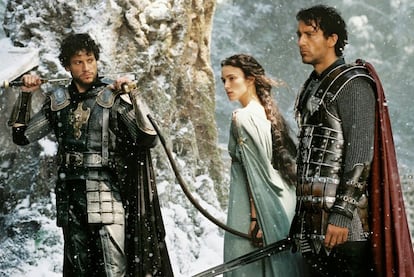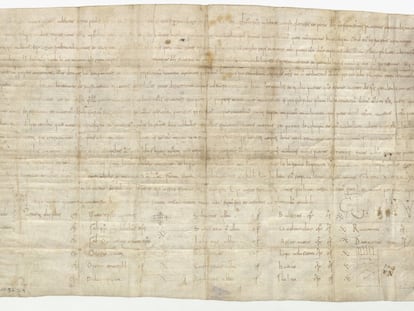
‘The Winter King’: Arthur, a warrior lord without a throne, in a violent and mysterious Dark Age
The series adaptation of the first novel from Bernard Cornwell’s splendid trilogy ‘The Warlord Chronicles’ doesn’t match the original’s mastery, but has its charms

King Arthur — or Arthur, as when we are referring to the possible historical character on which the legend was forged, and who would not have been a monarch, but rather, a military leader who fought under the banner of the bear (his name is derived from arth, meaning bear in Welsh) — has known many incarnations prior to his arrival at The Winter King. The first season of the TV show, now available on Amazon and Roku, is based on the wonderful novel by the same name, written by Bernard Cornwell, that kicks off his Warlord Chronicles trilogy.
We all have our favorite Arthurs, and preferences for this or that depiction of the world that surrounded the character. There are those who opt for Guy Ritchie’s wild King Arthur: The Legend of Excalibur (2017). This journalist (in addition to more exalted individuals, like Arthurian scholar Victoria Cirlot) is inclined towards John Boorman’s Excalibur (1987), and never fails to be moved by several of its scenes: when young Arthur is knighted in extremis, in the middle of a fight in a castle moat; when Arthur and his son Mordred kill each other before a dying, blood-red sun, or when Lady of the Lake’s hand, holding the king’s sword, disappears under the water as Siegfried’s funeral march plays in the background.
Boorman’s version, with its poetry and glittering armor (akin to Robert Bresson’s beautiful 1974 Lancelot of the Lake), is a fairly canonical vision of the Arthurian subject, based on Malory’s The Death of Arthur (1485), in which the story’s basic, familiar elements appear: the Grail, the Round Table, the adulterous love of Lancelot and Guinevere, the sword in the stone, etc. These pieces appear in the large part of the productions that have been made about Arthur and his world, from the musical Camelot (1967) to First Knight (1995), with Sean Connery and Richard Gere, to the unbeatable Monty Python and the Holy Grail (1975), and let us not forget the starting point for so many of us: Disney’s Merlin (1963).
Parallel to these creations, which are more or less driven by the norms of chivalric novels, and as Michel Pastoreau would call them, “as passionate as they are fictional” (a quote from the French language La vie quotidienne en France et en Angleterre au temps des chevaliers de la Table ronde or Daily Life in France and England at the Time of the Hnights of the Round Table), another genre has developed that aspires to be euhemerist (give rational explanations to myths) or historicist, and that seeks to tell us, using sources such as Nennius, Gildas, Monmouth and archaeology, the “real” story of Arthur. This tale is set much earlier than the traditional yarns, in the Dark Ages of post-Roman Britain (the fourth and fifth centuries) and the barbarian invasions of the island.

Part of this school is the pioneering early 1970s BBC series Arthur of the Britons, in which there are no magical elements and the protagonist is a Celtic warrior leader facing down Anglo-Saxon invaders. Here too, one finds films such as Antoine Fuqua’s King Arthur (2004) with Clive Owen and Keira Knightley, in which Arthur is a Roman commander (Artorius) who leads a Samartian cavalry troop (Merlin, in this version, is Pictish). One of the school’s most important creations, which was received enthusiastically at the end of the 1990s, when its first editions were published by St. Martin’s Press in the United States, was Bernard Cornwell’s The Warlord Chronicles trilogy of novels, which opened with The Winter King (1996), followed by The Enemy of God (1997) and Excalibur (1998). The series, which Cornwell originally began to publish in the U.K. in 1995, follows the story of Arthur with the aforementioned historicist perspective. The author introduced the theme of religion (the confrontation between the old pagan and Druidic beliefs with Christianity) and magic in a very subtle way so as not to alter the fundamentally realistic tone of the narrative.
Even in the extensive bibliography of Cornwell (who turns 80 on February 23), The Warlord Chronicles count as his favorite works, and those of many of his readers. They were published after he began his successful novel series of the Napoleonic Wars rifleman Richard Sharpe, and before the immensely popular series dedicated to the time of Alfred the Great (ninth century), The Last Kingdom — both of which have been adapted for television, the latter becoming a celebrated, five-season Netflix series. Viewers of The Last Kingdom — which competed with Vikings, with which it shared similar themes — will be familiar with many aspects of the new Winter King. Like The Last Kingdom’s protagonist Uhtred of Bebbanburg, who was raised among the Vikings before entering the service of King Alfred, Derfel Cardarn, our protagonist (and narrator, in the novel) is an outsider and enemy, a young Saxon who, picked up wounded by Arthur, enters the service of the British kingdom of Dumnonia amidst a power struggle on the island. Like Uhtred, he will also become a warrior.

In The Winter King (the title refers not to Arthur, but to his cousin Mordred) we get Cornwell’s trademark tone of dirty, violent epic war in all its atrocity, extremely realistic fight scenes, the unmistakable style of a man who has become the master of the historical war novel (and from whose cup so many have drunk: depictions of sword and lance wounds will never be the same after Cornwell).
Bringing a book like The Winter King to the big screen was a difficult undertaking, given the novel’s large number of characters, settings and events, including its scenes of magic and battles. The TV series has already received its share of criticism due to its inability to translate Cornwell’s creation in all its power — and there is a certain poverty in production values (Avalon is not up to this task), which constitutes a sin in period narratives. Nonetheless, there are good things that make it interesting, and even interesting to watch. Here and there, Cornwell’s imagination and narrative pulse break through, with all the shocking savagery that permeates his Dark Ages. Some characters are quite well-captured; King Uther Pendragon (Eddie Marsan) and his irrational hatred for the bastard Arthur; the Silurian King Gundleus (Simon Merrells), who is a great villain (the scene in which he makes Norwenna kiss his sword, then sticks it down her throat to the hilt is pure Cornwell, though it has some seeing Game of Thrones, a connection heightened by the winter setting). Above all, Nimue (the legendary Viviana, the Lady of the Lake), the young Druidess apprentice of Merlin and co-protagonist of the story, played in my opinion very well by the actress Ellie James. Her rape scene has proved controversial, but it is indispensable to the story (it is the “second wound” that awakens her powers).
One of the best parts of Cornwell’s trilogy, which the series preserves, is how it gives voice and weight to the women of the Arthurian world, along the lines of Marion Zimmer Bradley’s The Mists of Avalon (1982), which was adapted into a TV series in 2001, and Cursed (2020), the series adaptation of the graphic novel about Nimue by Thomas Wheeler and Frank Miller. Of course, it’s a pity that Morgana does not appear in The Winter King series, deformed and covered with a golden mask, as she does in the novel: they thought she would appear too similar to the leprous king of Kingdom of Heaven, or to the Mordred of Boorman’s son Charley in Excalibur.
Merlin is Black in this series (Guinevere, played by Jordan Alexandra, is mixed race), as are many other characters (as far as I remember in the novel, only Sagramor, Numidian commander of Arthur’s fearsome cavalry, was Black). It’s a sign of the times, similar to Bridgerton (in which Alexandra also appeared, by the way). The tower of Avalon looks like something you would find in Mali. Iain de Caestecker’s Arthur is a bit inexpressive (except during the series of blows he receives in the beginning, perhaps to establish Cornwell’s oeuvre, though the event does not take place in the novel). It is also true that he is not Cornwell’s favorite character. The author even describes him as “not excessively beautiful” (and clad in Roman chainmail; accompanied by, yes, Excalibur a.k.a. Caledfwlch, which was supplied to him by Merlin and which hangs from his belt). Fight scenes are suitably bloody, although it seems to me that there is a lack of conviction and pulse in chosen weapons and shield wall (a concept, by the way, invented by Cornwell). Anyway, let’s see how the series goes, if there are new seasons to cover the entirety of the magnificent original trilogy, and if the same twists of the novels’ Guinevere and Lancelot await us on the screen…
Sign up for our weekly newsletter to get more English-language news coverage from EL PAÍS USA Edition
Tu suscripción se está usando en otro dispositivo
¿Quieres añadir otro usuario a tu suscripción?
Si continúas leyendo en este dispositivo, no se podrá leer en el otro.
FlechaTu suscripción se está usando en otro dispositivo y solo puedes acceder a EL PAÍS desde un dispositivo a la vez.
Si quieres compartir tu cuenta, cambia tu suscripción a la modalidad Premium, así podrás añadir otro usuario. Cada uno accederá con su propia cuenta de email, lo que os permitirá personalizar vuestra experiencia en EL PAÍS.
¿Tienes una suscripción de empresa? Accede aquí para contratar más cuentas.
En el caso de no saber quién está usando tu cuenta, te recomendamos cambiar tu contraseña aquí.
Si decides continuar compartiendo tu cuenta, este mensaje se mostrará en tu dispositivo y en el de la otra persona que está usando tu cuenta de forma indefinida, afectando a tu experiencia de lectura. Puedes consultar aquí los términos y condiciones de la suscripción digital.
More information
Archived In
Últimas noticias
There is as much life left to discover on planet Earth as that which is already known
Dozens presumed dead, around 100 injured in fire at Swiss Alps bar during New Year’s celebration
Is porn for women different from conventional porn? We spoke to those who make it
Cartagena de Indias is sinking: What can the city do to mitigate it?
Most viewed
- Reinhard Genzel, Nobel laureate in physics: ‘One-minute videos will never give you the truth’
- David King, chemist: ‘There are scientists studying how to cool the planet; nobody should stop these experiments from happening’
- Oona Chaplin: ‘I told James Cameron that I was living in a treehouse and starting a permaculture project with a friend’
- Sinaloa Cartel war is taking its toll on Los Chapitos
- The Interoceanic Train, the Mexican alternative to the Panama Canal










































